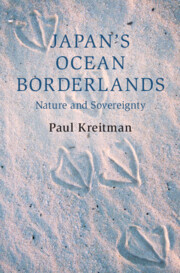Book contents
- Japan’s Ocean Borderlands
- Cambridge Oceanic Histories
- Japan’s Ocean Borderlands
- Copyright page
- Contents
- Maps
- Figures
- Acknowledgements
- Naming Conventions
- Maps
- Introduction
- 1 Bonins of Contention
- 2 The Race to Marcus Island
- 3 Bird and Sovereignty Conservation in the Northwest Hawaiian Islands, 1898–1911
- 4 Sand Dunes and Soldiers
- 5 Disaster
- 6 Resurrecting the Torishima Albatross
- 7 The Nature of the Senkaku Islands
- Epilogue
- Appendix Japanese Islands Abandoned, 1868–2013
- Select Bibliography
- Index
3 - Bird and Sovereignty Conservation in the Northwest Hawaiian Islands, 1898–1911
Published online by Cambridge University Press: 06 July 2023
- Japan’s Ocean Borderlands
- Cambridge Oceanic Histories
- Japan’s Ocean Borderlands
- Copyright page
- Contents
- Maps
- Figures
- Acknowledgements
- Naming Conventions
- Maps
- Introduction
- 1 Bonins of Contention
- 2 The Race to Marcus Island
- 3 Bird and Sovereignty Conservation in the Northwest Hawaiian Islands, 1898–1911
- 4 Sand Dunes and Soldiers
- 5 Disaster
- 6 Resurrecting the Torishima Albatross
- 7 The Nature of the Senkaku Islands
- Epilogue
- Appendix Japanese Islands Abandoned, 1868–2013
- Select Bibliography
- Index
Summary
Chapter 3 shifts the focus to the Hawaiian archipelago, c.1898–1911, newly annexed to the US as part of the sudden irruption of American empire in the Pacific. American ornithologists and naval officers discovered that Japanese bird-hunters were regularly operating on otherwise uninhabited atolls in the outlying Northwest Hawaiian group. Inspired by a mixture of concern for animal welfare, geopolitics (the islands were potentially valuable as cable-landing stations) and ambient racial anxiety about Japanese immigration, US colonial administrators deployed nature conservation as a means of asserting sovereignty over uninhabited space. Key to this process was the scientist William Alanson Bryan, who had witnessed the Marcus Island Incident at first hand and was determined to protect both American birds and territory from Japan’s advance into the Pacific. To this end, he successfully lobbied Theodore Roosevelt to establish the Hawaiian Islands Reservation, forerunner of today’s Papahānaumokuākea Marine National Monument.
Keywords
- Type
- Chapter
- Information
- Japan's Ocean BorderlandsNature and Sovereignty, pp. 88 - 126Publisher: Cambridge University PressPrint publication year: 2023



